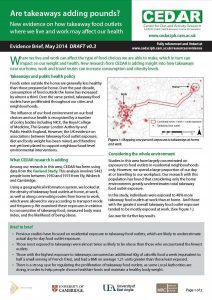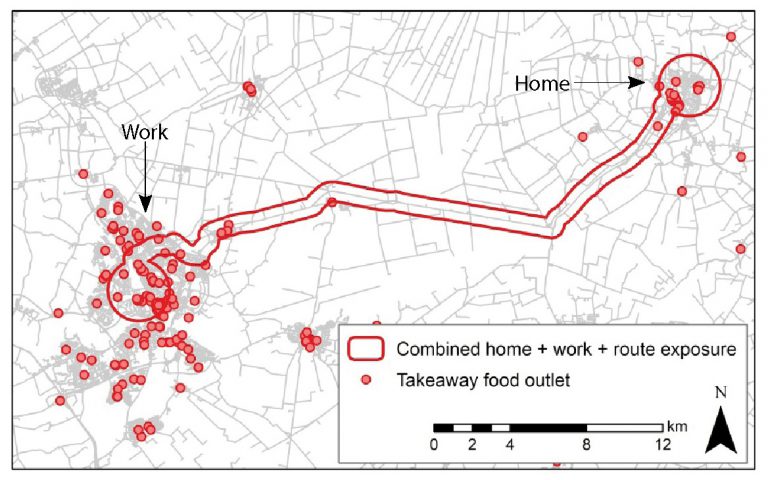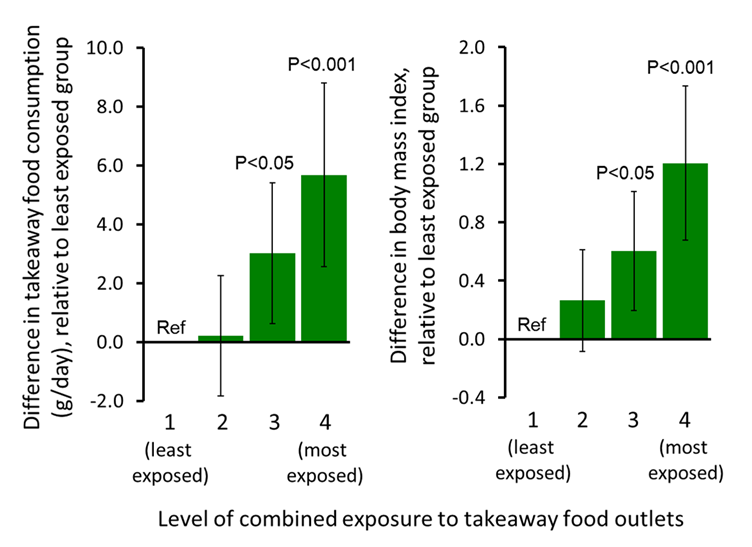How takeaway food outlets where we live and work may affect our health – June 2014
Where we live and work can affect the type of food choices we are able to make, which in turn can impact on our weight and health. New research from CEDAR is adding insight into how takeaways near our home, work and travel routes can increase consumption and obesity levels.
Jump to:
- Takeaways & public health policy
- What CEDAR research is adding
- Considering the whole environment
- Key results from Fenland analysis
- Future research
- Policy implications
- References & resources
Brief in brief
- Previous studies have focused on residential exposure to takeaway food outlets, which are likely to underestimate actual day-to-day food outlet exposure.
- Those most exposed to takeaways were almost twice as likely to be obese than those who encountered the fewest outlets.
- Those with the highest exposure to takeaways consumed an additional 40g of calorific food a week (equivalent to half a small serving of French fries), and had a BMI on average 1.21 units greater than those least exposed.
- There is a strong case for regulating the proliferation of takeaway food outlets, as some Local Authorities are doing, in order to help people choose healthier foods and maintain a healthy body weight.
Takeaways and public health policy
Foods eaten outside the home are generally less healthy than those prepared at home. Over the past decade, consumption of food outside the home has increased by almost a third. Over the same period, takeaway food outlets have proliferated throughout our cities and neighbourhoods.
The influence of our food environment on our health is recognised by a number of policy bodies including the Greater London Authority, NICE and Public Health England. A number of Local Authorities, including Waltham Forest and Barking & Dagenham, are already regulating the proliferation of new takeaway food outlets.
However, the UK evidence on associations between takeaway food outlet exposure, diet and body weight has been mixed, and therefore not yet best placed to support neighbourhood-level environmental interventions.
What CEDAR research is adding
Among our research in this area, CEDAR has been using data from the Fenland Study. This analysis involves 5442 people born between 1950 and 1975 from Ely, Wisbech and Cambridge.
Using a geographical information system, we looked at the density of takeaway food outlets at home, at work, as well as along commuting routes from home to work, which were allowed to vary according to transport mode and frequency. We examined these exposures in relation to consumption of takeaway food, measured body mass index, and the likelihood of being obese.
Considering the whole environment
Studies in this area have largely concentrated on exposure to food outlets in residential neighbourhoods only. However, we spend a large proportion of our day at or travelling to our workplace. Our research with this population has found that considering only the home environments greatly underestimates total takeaway food outlet exposure.
In this study, individuals were exposed to 48% more takeaway food outlets at work than at home. And those with the greatest overall takeaway food outlet exposure tended to be mostly exposed at work. (See figure 1 below.) Mapping one person’s exposure to takeaways at home and work.
Figure 1: Mapping one person’s exposure to takeaways at home and work
Key results from the Fenland analysis include:
- Participants were exposed to an average of 32 takeaway food outlets – nine each in their residential neighbourhood and on their commute, and 14 within a mile of work.
- Participants were exposed to as many as 165 outlets across home, work and commuting environments.
- Takeaway exposure was associated with increased takeaway consumption: those with the highest exposure consumed an additional 40g of calorific food per week (equivalent to half a small portion of takeaway French fries), relative to the least exposed.
- Takeaway exposure was also strongly associated with a greater Body Mass Index (BMI). Those with the highest exposure to takeaways had a body mass index on average 1.21 BMI units greater than those least exposed (see Figure 2).
- Those with the highest takeaway exposure were also almost twice as likely to be obese as those least exposed.
Figure 2: Association between combined exposure to takeaway food outlets, takeaway food consumption, and body mass index
Future research
This cross-sectional research shows strong and consistent associations between takeaway exposure, diet and body weight, but studies conducted over time are necessary to identify what might be causing these associations.
Current CEDAR research is investigating whether these observed associations are consistent across socioeconomic groups, for example between those with high or low levels of education. Future CEDAR research will seek to capture Fenland Study participants’ exposure to takeaway food outlets more completely using GPS tracking data.
Researchers are collaborating with policymakers and planners to determine the implications of these results. To discuss the results further, please contact Dr Tom Burgoine, tb464@cam.ac.uk
Policy implications
- The causes of obesity are complex, and inevitably extend beyond neighbourhood access to takeaway food. Nevertheless, limiting the number of takeaway food outlets encountered on a daily basis may be one way of positively influencing diets and body weight.
- In a bid to curb obesity levels, some local authorities have begun to place restrictions on the opening of new takeaway food outlets, such as exclusion zones around schools and limits on how many takeaways can cluster along high streets.
- Although more substantial and joined-up environmental intervention may be required, CEDAR research suggests that these policies may constitute an important part of future UK public health policy.
References and resources
Research
- Associations between exposure to takeaway food outlets, takeaway food consumption, and body weight in Cambridgeshire, UK: population based, cross sectional study, BMJ 2014;348:g1464 www.bmj.com/content/348/bmj.g1464
- Characterising food environment exposure at home, at work, and along commuting journeys using data on adults in the UK IJBNPA 2013, 10:85 www.ijbnpa.org/content/10/1/85
Policy and guidance
- NICE diet recommendations, including standards for takeaways and food outlets, 2014: http://pathways.nice.org.uk/pathways/diet
- Healthy people, healthy places briefing: obesity and the environment: regulating the growth of fast food outlets. Public Health England, 2014. http://bit.ly/1mPJ3Cn
- GLA Takeaway toolkit: www.london.gov.uk/sites/default/files/takeawaystoolkit.pdf
- Saturation point – addressing the health impacts of hot food takeaways: supplementary planning document, 2010. Barking & Dagenham: www.lbbd.gov.uk/sites/default/files/2022-09/Saturation-Point-SPD-Addressing-the-Health-Impacts-of-Hot-Food-Takeaway.pdf
Please cite this Evidence Brief as: UKCRC Centre for Diet and Activity Research (CEDAR), Evidence Brief 7: Are takeaways adding pounds? How takeaway food outlets where we live and work may affect our health – June 2014. www.mrc-epid.cam.ac.uk/resources/policy-resources/evidence-briefs/eb-takeaways-obesity/

 MRC Epidemiology Unit
MRC Epidemiology Unit

